Drawing models of aircraft from the Second World War. Military radio-controlled aircraft
War creates a need never seen in peacetime. Countries compete to create the next most powerful weapon, and engineers sometimes resort to intricate methods for designing their killing machines. Nowhere else has this been shown more clearly than in the skies of World War II: daring aircraft designers have invented some of the strangest aircraft in human history.
Blohm & Voss BV 141
At the start of World War II, the German Imperial Air Ministry stimulated the development of a tactical reconnaissance aircraft to provide information support for army operations. Two companies responded to the task. Focke-Wulf modeled a fairly standard twin-engine airplane, while Blohm & Voss miraculously came up with one of the most unusual aircraft at the time, the asymmetric BV 141.
Although at first glance it may seem that this model was dreamed of by engineers in delirium, it successfully served certain purposes. By removing the skin from the right side of the aircraft, the “BV 141” gained an incomparable field of view for the pilot and observers, especially to the right and front, as the pilots were no longer burdened by the huge engine and rotating propeller of the familiar single-engine aircraft.
The design was developed by Richard Vogt, who realized that the then aircraft already had, in fact, asymmetrical handling characteristics. With a heavy engine in the nose, the single-engine aircraft experienced high torque, requiring constant attention and control. Vogt sought to compensate by introducing an ingenious asymmetric design, creating a stable reconnaissance platform that was easier to fly than most of her contemporary airliners.
Luftwaffe officer Ernst Udet praised aircraft during a test flight at speeds up to 500 kilometers per hour. Unfortunately for Blohm & Voss, Allied bombing severely damaged one of Focke-Wulf's main factories, forcing the government to dedicate 80 percent of Blohm & Voss's production space to building Focke-Wulf aircraft. Since the company's already tiny staff began to work for the benefit of the latter, work on the "BV 141" was stopped after the release of only 38 copies. All of them were destroyed during the war.
Horten Ho 229
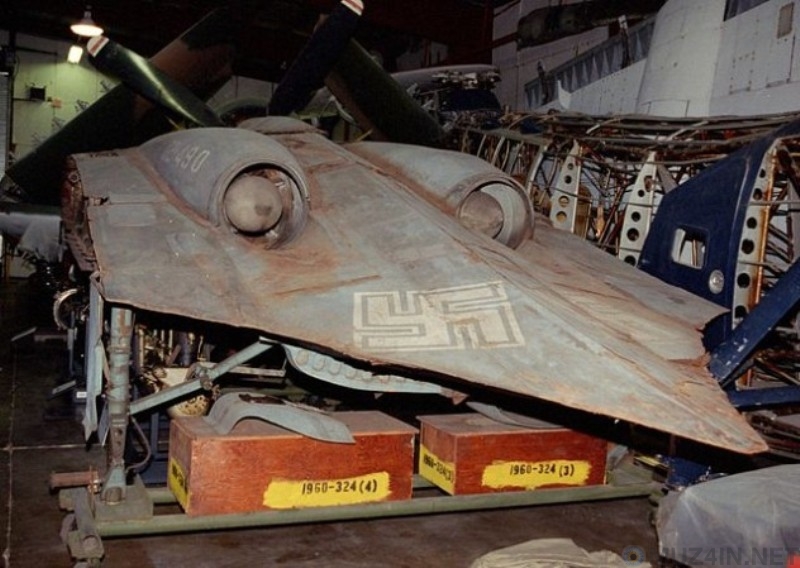
Another unusual Nazi project, "Horten Ho 229", was launched almost before the end of the war, after German scientists improved jet technology. By 1943, the Luftwaffe commanders realized that they had made a huge mistake by refusing to issue a long-range heavy bomber, like the American B-17 or the British Lancaster. To rectify the situation, the commander-in-chief of the German air force, Hermann Goering, put forward the demand "3x1000": to develop a bomber capable of transporting 1000 kilograms of bombs over a distance of 1000 kilometers at a speed of at least 1000 kilometers per hour.
Fulfilling the order, the Horten brothers set about designing a "flying wing" (a type of aircraft without a tail or fuselage, like later stealth bombers). In the 1930s, Walter and Raymar experimented with gliders of this type, which showed excellent handling characteristics. Using this experience, the brothers built a non-powered model to reinforce their bomber concept. The design impressed Göring, who handed over the project to the Gothaer Waggonfaebrik aircraft manufacturer for mass production. After some refinement, the Horten glider acquired jet engine. It was also converted into a fighter aircraft for the needs of the Luftwaffe in 1945. They managed to create only one prototype, which, at the end of the war, was placed at the disposal of the allied forces.
At first, "Ho 229" was considered simply as an outlandish trophy. However, when the similarly designed B-2 stealth bomber entered service, aerospace experts became interested in the stealth performance of its German ancestor. In 2008, Northrop Grumman engineers recreated a copy of the Ho 229 based on a surviving prototype held by the Smithsonian. By emitting radar signals at frequencies used during World War II, experts discovered that the Nazi aircraft was in fact directly related to stealth technology: it had much less visibility in the radar range compared to its combat contemporaries. Quite by accident, the Horten brothers invented the first stealth fighter-bomber.
Vought V-173/XF5U-1
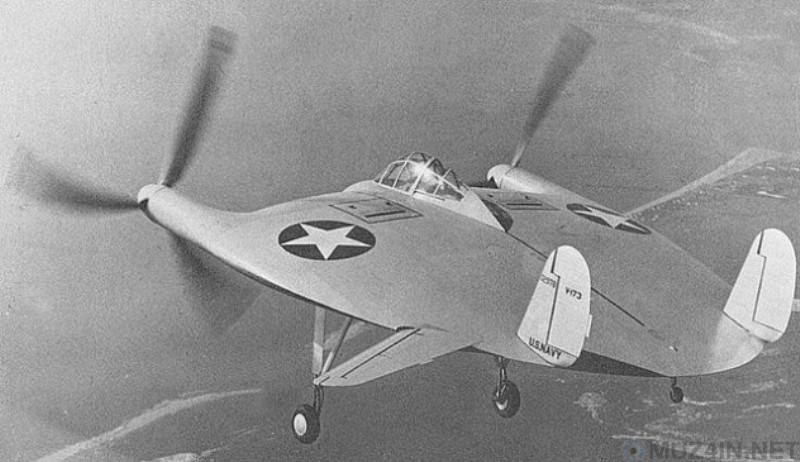
In the 1930s, Vought engineer Charles H. Zimmerman began experimenting with disc-shaped aircraft. The first flying model was the V-173, which took to the air in 1942. He had problems with the gearbox, but in general it was a durable, highly maneuverable aircraft. While his firm was churning out the famous "F4U Corsair", Zimmerman continued to work on the disk-shaped fighter that would eventually see the light of day as the "XF5U".
Military experts assumed that the new “fighter” would in many ways surpass other aircraft available at that time. Equipped with two huge Pratt & Whitney engines, the aircraft was expected to reach a high speed of about 885 kilometers per hour, decelerating to 32 kilometers per hour on landing. To give the airframe strength while keeping the weight as low as possible, the prototype was built from "metalite", a material consisting of a thin sheet of balsa wood coated with aluminium. However, various problems with the engines gave Zimmerman a lot of trouble, and the Second World War completed before they could be eliminated.
Vought did not cancel the project, but by the time the fighter was ready for testing, the US Navy decided to focus on jet aircraft. The contract with the military expired, and Vought employees tried to dispose of the XF5U, but it turned out that the metalite structure was not so easy to destroy: the demolition ball that hit the airplane only bounced off the metal. Finally, after several new attempts, the body of the aircraft caved in, and blowtorches incinerated its remains.
Boulton Paul Defiant
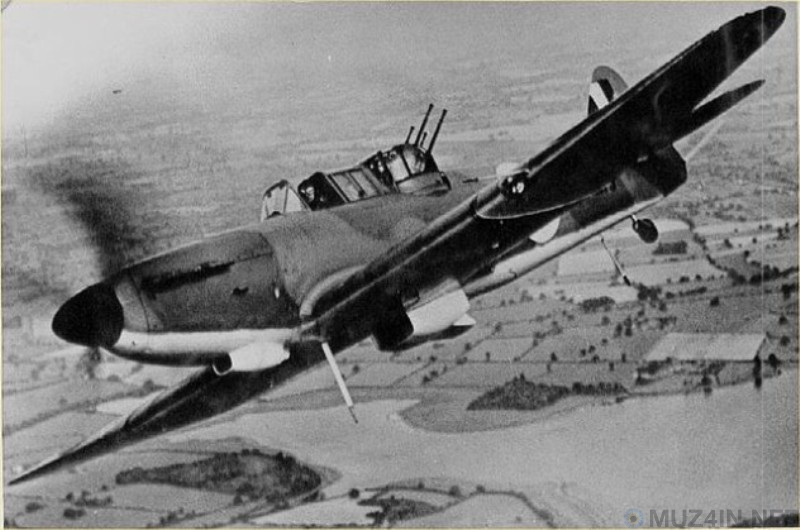
Of all the aircraft presented in the article, the Boulton Paul Defiant has been in service longer than others. Unfortunately, this resulted in many deaths of young pilots. The airplane appeared as a result of the delusion of the 1930s regarding the further development of the situation on the air front. The British command believed that the enemy bombers would be unprotected and mostly without reinforcements. In theory, a fighter with a powerful turret could penetrate the attack formation and destroy it from the inside. Such an arrangement of weapons would free the pilot from the duties of a shooter, allowing him to concentrate on bringing the aircraft to the optimal firing position.
And the Defiant did an excellent job during its first sorties of operations, as many unsuspecting German fighter pilots mistook the aircraft for the outwardly similar Hawker Hurricane, attacking it from above or from the rear - ideal points for a machine gunner Defiant. However, the Luftwaffe pilots quickly realized what was happening, and began to attack from below and in front. With no frontal weapons and low maneuverability due to the heavy turret, the Defiant aviators suffered huge losses during the Battle of Britain. The Air Force of Foggy Albion lost almost an entire fighter squadron, and the Defiant gunners were not able to leave the plane in emergency situations.
Although the pilots managed to come up with various timing tactics, the Royal air Force soon realized that the turret fighter was not intended for modern air combat. The Defiant was demoted to a night fighter, after which he gained some success sneaking up and destroying enemy bombers on night missions. The rugged hull of the British was also used as a target for practice shooting and in testing the first Martin-Baker ejection seats.
Bell YFM-1 Airacuda
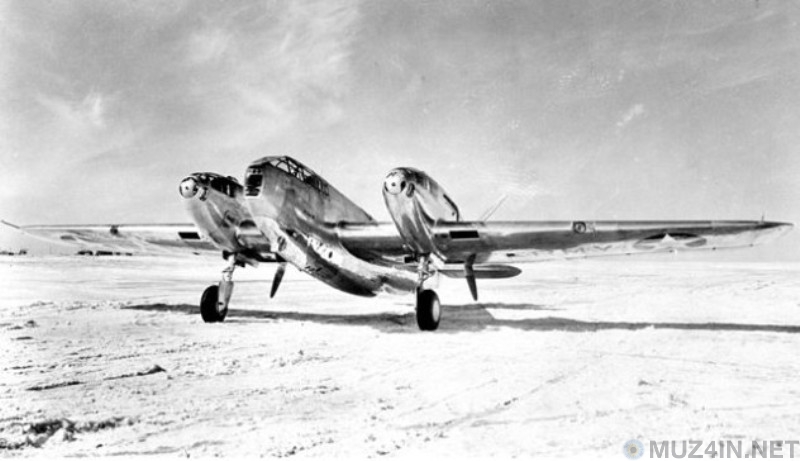
Between the First and Second World Wars in various states there was growing concern about the issue of defense against strategic bombing during the next hostilities. Italian general Giulio Due believed that it was impossible to defend against massive air attacks, and British politician Stanley Baldwin coined the phrase "a bomber will always break through." In response, the major powers have invested heavily in the development of "bomber destroyers" - heavy fighters designed to intercept enemy formations in the sky. The English "Defiant" failed, while the German "BF-110" performed well in various roles. And finally, among them was the American "YFM-1 Airacuda".
This aircraft was Bell's first foray into the military aircraft industry and featured many unusual features. In order to give the Airacuda the highest chance of destroying the enemy, Bell equipped it with two 37mm M-4 guns, placing them in front of the sparse pusher engines and propellers located behind them. Each gun was assigned a separate shooter, whose main duty was to manually reload it. Initially, gunners also fired weapons directly. However, the results were a disaster, and the design of the aircraft was changed, putting the control levers of the guns in the hands of the pilot.
Military strategists believed that with additional machine guns in defensive positions - in the main fuselage to fend off side attacks - the aircraft would be indestructible both when attacking enemy bombers and when escorting B-17s over enemy territories. All these structural elements gave the aircraft a rather voluminous appearance, making it look like a cute cartoon airplane. The Airacuda was a real death machine that looked like it was made to be hugged.
Despite optimistic forecasts, tests revealed serious problems. The engines were prone to overheating and did not produce enough thrust. Therefore, in reality, Airacuda developed a lower maximum speed than the bombers it was supposed to intercept or protect. The original arrangement of the weapon only added to the complexity, since the gondolas in which it was placed were filled with smoke when fired, making it impossible for the machine gunners to work. On top of that, they couldn't get out of their cockpits in an emergency because the propellers were working right behind them, turning their attempt to escape into a meeting with death. As a result of these problems, the US Army Air Force only purchased 13 aircraft, none of which received a baptism of fire. The remaining gliders dispersed around the country for the pilots to add notes about the strange aircraft in their logbooks, and Bell continued to try (already more successfully) to develop a military aircraft.
"Antonov A-40"

Despite the arms race, military gliders were an important part of World War II aerial technology. They were lifted into the air in tow and detached near enemy territories, ensuring the rapid delivery of supplies and troops as part of airborne operations. Among all the gliders of that period, the "flying tank" "A-40" of Soviet production, of course, stood out for its design.
The countries participating in the war were looking for ways to quickly and efficiently transport tanks to the front. Transferring them with gliders seemed like a worthwhile idea, but engineers soon discovered that the tank was one of the most aerodynamically imperfect machines. After countless attempts to create good system for the supply of tanks by air, most states simply surrendered. But not the USSR.
In fact, Soviet aviation already had some success in landing tanks before the A-40 was developed. Small vehicles like the T-27 were lifted aboard huge transport planes and dropped a few meters from the ground. With the gearbox in the neutral position, the tank landed and rolled by inertia to a stop. The problem was that the tank crew had to be delivered separately, which greatly reduced the combat effectiveness of the system.
Ideally, the tankers should have arrived in a tank and be ready for battle after a few minutes. To achieve these goals, Soviet planners turned to the ideas of American engineer John Walter Christie, who first developed the concept of a flying tank in the 1930s. Christie believed that, thanks to armored vehicles with fitted biplane wings, any war would be instantly over, since no one could defend against a flying tank.
Based on the work of John Christie Soviet Union crossed the T-60 with an aircraft and in 1942 conducted the first test flight with the brave pilot Sergei Anokhin at the helm. And although due to the aerodynamic drag of the tank, the glider had to be taken out of tow before reaching the planned height, Anokhin managed to land softly and even brought the tank back to base. Despite the enthusiastic report compiled by the pilot, the idea was rejected after Soviet specialists realized that they did not have aircraft powerful enough to tow operational tanks (Anokhin flew with a lightweight machine - without most of the weapons and with a minimum supply of fuel). Unfortunately, the flying tank never left the ground again.
Junkers Ju-287
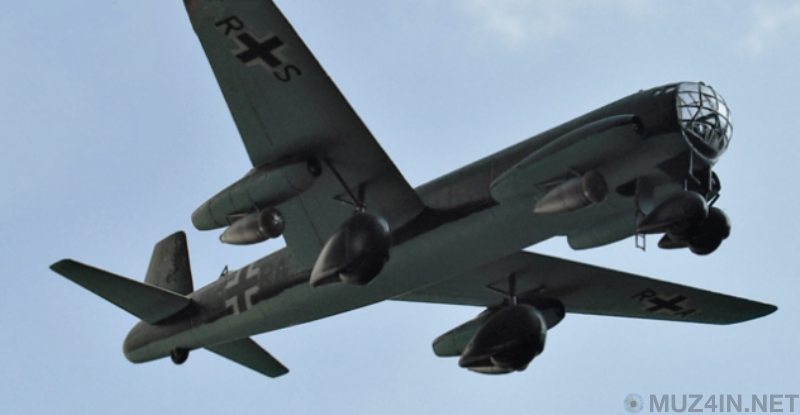
After Allied bombing began to undermine the German war effort, Luftwaffe commanders realized that their failure to develop heavy multi-engined bombers was a huge mistake. When the authorities finally established the corresponding orders, most of the German aircraft manufacturers seized on this opportunity. Among them were the Horten brothers (as noted above) and the Junkers, who already had experience in building bombers. Company engineer Hans Focke led the design of perhaps the most advanced German aircraft during the Second World War - "Ju-287".
In the 1930s, designers came to the conclusion that a straight-wing aircraft had a certain upper speed limit, but at that time it did not matter, since turboprop engines could not get close to these indicators anyway. However, with the development of jet technologies, everything has changed. German specialists used swept wings in the early jet aircraft, such as the Me-262, which avoided the problems - air compression effects - inherent in a straight wing design. Focke took this one step further and proposed to release an aircraft with a reverse swept wing, which, he believed, would be able to defeat any air defense. The new type of wing had a number of advantages: increased maneuverability at high speeds and at high angles of attack, improved stalling characteristics and freed the fuselage from weapons and engines.
First, Focke's invention passed aerodynamic tests using a special stand; many parts of other aircraft, including captured allied bombers, were taken to make the model. The Ju-287 proved to be excellent during test flights, confirming compliance with all the declared operational characteristics. Unfortunately for Focke, interest in jet bombers quickly waned, and his project was shelved until March 1945. By then, desperate Luftwaffe commanders were looking for any fresh ideas to inflict damage on the Allied forces - production of the Ju-287 was launched in record time, but two months later the war ended, after the construction of only a few prototypes. It took another 40 years for the popularity of the reverse swept wing to begin to revive, thanks to American and Russian aerospace engineers.
Cornelius XFG-1
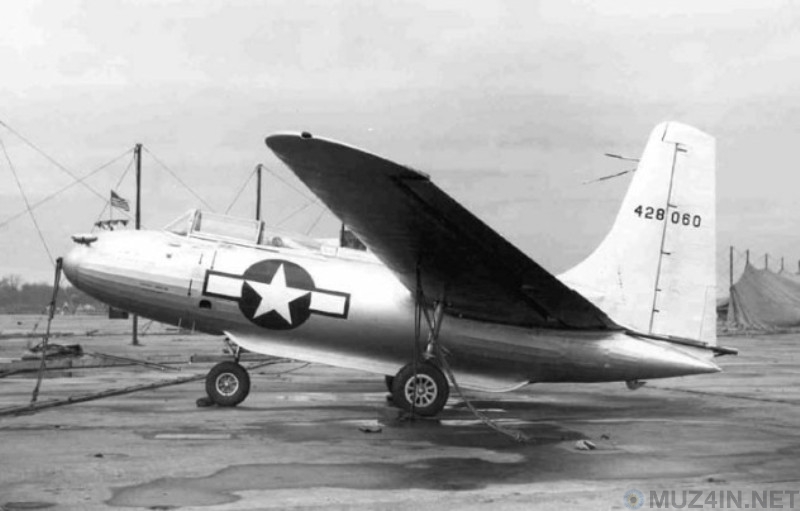
George Cornelius is a famous American engineer, designer of a number of extravagant gliders and aircraft. During the 30s and 40s he worked on new types of aircraft designs, among other things - experimenting with swept back wings (like the "Ju-287"). His gliders had excellent stalling characteristics and could be towed at high speeds without much braking effect on the towing aircraft. When World War II broke out, Cornelius was brought in to develop the XFG-1, one of the most specialized aircraft ever built. In essence, the "XFG-1" was a flying fuel tank.
George's plans were to produce both manned and unmanned versions of his glider, both of which could be towed by the latest bombers at their cruising speed of 400 kilometers per hour, twice the speed of most other gliders. The idea of using the unmanned "XFG-1" was revolutionary. The B-29s were expected to tow the glider, pumping fuel from its tank through connected hoses. With a tank capacity of 764 gallons, the XFG-1 would have acted as a flying gas station. After emptying the fuel storage, the B-29 would detach the airframe and it would dive to the ground and crash. This scheme would significantly increase the range of the bombers, allowing raids on Tokyo and other Japanese cities. The manned "XFG-1" would have been used in a similar way, but more rationally, since the glider could be landed, and not just destroyed at the end of the fuel intake. Although it is worth considering what kind of pilot would dare to take on such a task as flying a fuel tank over a dangerous war zone.
During testing, one of the prototypes crashed, and Cornelius's plan was left without further attention when the allied forces captured the islands near the Japanese archipelago. With the new airbase layout, the need to refuel the B-29s to reach their mission goals was eliminated, taking the XFG-1 out of the game. After the war, George continued to pitch his idea to the US Air Force, but by then their interest had shifted to specialized refueling aircraft. And “XFG-1” has simply become an inconspicuous footnote in the history of military aviation.
Zveno-SPB

The idea of creating a flying aircraft carrier first appeared during the First World War and was tested in the interwar period. In those years, engineers dreamed of a huge airship carrying small fighters capable of leaving the mother ship to protect it from enemy interceptors. British and American experiments ended in complete failure, and the idea was eventually abandoned, as the loss of tactical value by large rigid airships became apparent.
But while American and British specialists were curtailing their projects, the Soviet Air Force was just getting ready to enter the development arena. In 1931, aviation engineer Vladimir Vakhmistrov proposed using Tupolev's heavy bombers to lift smaller fighters into the air. This made it possible to significantly increase the range and bomb load of the latter in comparison with their usual capabilities as dive bombers. Without bombs, aircraft could also defend their carriers from enemy attacks. Throughout the 1930s, Vakhmistrov experimented with different configurations, only stopping when he attached as many as five fighters to one bomber. By the time the Second World War began, the aircraft designer revised his ideas and came up with a more practical scheme of two I-16 fighter-bombers suspended from the parent TB-3.
The Soviet High Command was impressed enough with this concept to try to put it into practice. The first raid on the Romanian oil storage facilities was successful, with both fighters detaching from the aircraft carrier and striking before returning to the Soviet forward base. After such a successful start, another 30 raids were made, the most famous of which was the destruction of the bridge near Chernovodsk in August 1941. The Red Army tried for months to no avail to destroy it, until they finally activated two of Vakhmistrov's monsters. The carrier planes released their fighters, which began to bomb the previously inaccessible bridge. Despite all these victories, a few months later, the Zveno project was closed, and the I-16 and TB-3 were discontinued in favor of more modern models. Thus ended the career of one of the strangest - but successful - creations of aviation in the history of mankind.
Fieseler Fi-103R
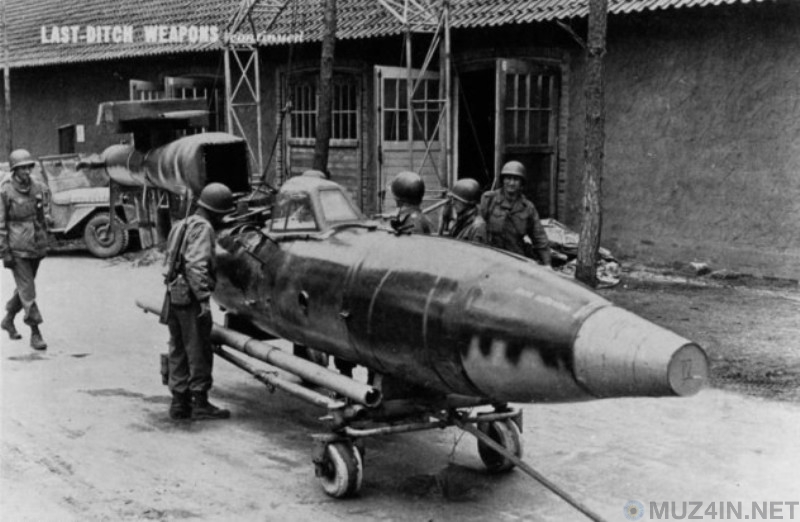
Most people are familiar with Japanese kamikaze missions using old aircraft loaded with explosives as anti-ship weapons. They even developed the MXY-7 special-purpose rocket glider. Less widely known is Germany's attempt to build a similar weapon by turning V-1 "cruise bombs" into manned "cruise missiles".
With the end of the war nearing, the Nazi high command was desperately looking for a way to interfere with Allied shipping across the English Channel. The V-1 shells had potential, but the need for extreme accuracy (which was never their advantage) led to the creation of a manned version. The German engineers managed to install a small cockpit with simple controls in the fuselage of the existing V-1, right in front of the jet engine.
Unlike ground-launched V-1 rockets, the Fi-103R manned bombs were supposed to be lifted into the air and launched from He-111 bombers. After that, the pilot needed to make out the target-ship, direct his plane at it, and then take off his feet.
German pilots did not follow the example of their Japanese colleagues and did not lock themselves in the cockpits of aircraft, but tried to escape. However, with the engine roaring just behind the cabin, the escape would probably be fatal anyway. These ghostly chances for the survival of the pilots spoiled the impression of the Luftwaffe commanders from the program, so not a single operational mission was destined to take place. However, 175 V-1 bombs were converted into Fi-103Rs, most of which ended up in Allied hands at the end of the war.
Of course, not every person sympathizes with flying on aircraft, but you can feel discomfort in an airplane, but love them outwardly, enjoy and admire the aerobatics of military aces, and since you have come to this site, it means that you like airplanes.
Of course, everyone knows that the plane can deliver passengers from point "A" to point "B" within a few hours, which is much faster than the fastest trains. But few people thought about the fact that aviation was created not only to transport people and goods, but also for completely different purposes. In world aviation great importance reserved for military aircraft. They are able to solve a huge number of tasks in peacetime, such as: patrolling state borders and suppressing their violation, fishing reconnaissance and detection of poachers, delivery of humanitarian aid, assistance in the operations of the Ministry of Emergency Situations, the fight against terrorism and much more. During military conflicts, aviation exists to resolve issues of a defensive and offensive nature, to conduct combat operations. Someone suggests that this type of aviation was in demand in countries only in wartime, however, this moment military aviation exists in every country and is an integral part of the armed forces. Moreover, scientists, technicians and engineers work every day not only to improve the combat performance and flight qualities of existing aircraft, but also to create new, more modern, advanced and technologically advanced prototypes and aircraft.
Do you have any idea about military aircraft? Do you know that models of civilian aircraft are many times larger than military ones, even if their scale is the same? We are sure that among the abundance of our customers there will be those whose life is inseparably connected with flights, and even with military aircraft - pilots, pilots, testers - it is for such people who are in love with their job that we offer you our models of military aircraft.
Our store has a wide variety of models of military aircraft, we have a Su-27 in the color of the Swifts aerobatic team and a Su-35 in combat camouflage, there is a MiG-15 painted in the color of the Soviet flag from the Red Five aerobatic team created in In 1934, by order of I.V. Stalin and the MiG-29 of modern aces from the Russian Knights, there is the legendary An-2 “corner” and the An-12 workhorse, the victorious Il-2 attack aircraft and the latest T-50. Here you can also find representatives of foreign aviation, such as: the French Mirage, in various bright tiger colors and Phantom in several variations, there are also representatives of American aerobatic teams, such as Thunderbirds (Petrels) from the US Air Force and pilots from the US Navy "Blue Angels" (Blue Angels). There are also strategic bombers in our store: the Russian Tu-95 "Bear", the American B-52 "Stratofortress" and the infamous bombing of Hiroshima and Nagasaki B-29 "Superfortress", which comes with a copy atomic bomb"Fat Man". And of course we have representatives of stealth technology, such as: B-2, F-35, F-22 "Raptor", there are also stealth unmanned aerial vehicles: X-47 "Pegasus" and MQ-1 "Predator" and the first aircraft created using the technology of reducing radar visibility SR-71 "Blackbird" (Blackbird), which still impresses with its futuristic forms. He was far ahead of his time and, due to the high cost of construction, he served less than he could, but managed to set several records, one of which is the absolute speed record among manned aircraft with ramjet engines - 3529.56 km / h. It was the only American aircraft that was never shot down by North Vietnamese air defense systems during the Vietnam War.
Here you can purchase both aircraft produced today and rare models of the Limited Edition series, the number of which is limited and production has been stopped. All aircraft models are authentic copies of real military combat vehicles with a certain coloring and accessories.
Combat aircraft are not just a souvenir or craft, they capture the spirit of wartime. As a gift for a lover military equipment, to someone who once served in the Air Force, to a person whose profession is related to military aviation, or to a veteran relative in memory of the Second World War, such aircraft are indispensable. You can be sure that such a gift will not leave anyone indifferent, because military aviation is a big, unfinished chapter in the history of every country.
There is no such boy who, at least once in his life, has not peered into the sky, fascinated, following the graceful movement of an aircraft weighing several tons, imagining himself as this fearless aviator who directs a combat vehicle to the position of the enemy. Now radio-controlled aircraft give the opportunity to fulfill a dream at absolutely any age, even if this boy is no longer a child, but buys a military radio-controlled aircraft for his son or himself.
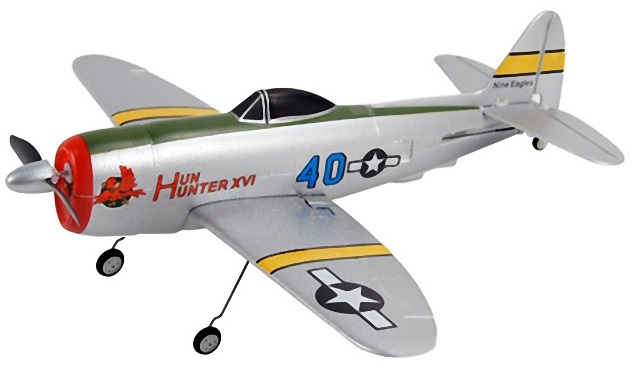 What is special about military radio-controlled aircraft?
What is special about military radio-controlled aircraft?
Firstly, a unique warpaint that fully matches the natural coloring of each fighter. Secondly, such airliners are able to repeat all the incredible aerobatics of a real aircraft. And, thirdly, the maneuverability of military radio-controlled aircraft makes it possible even for an experienced pilot to improve his skills in controlling his pet. For every guy, a military aircraft is a unique chance to feel like a real hero. Among the special properties are:
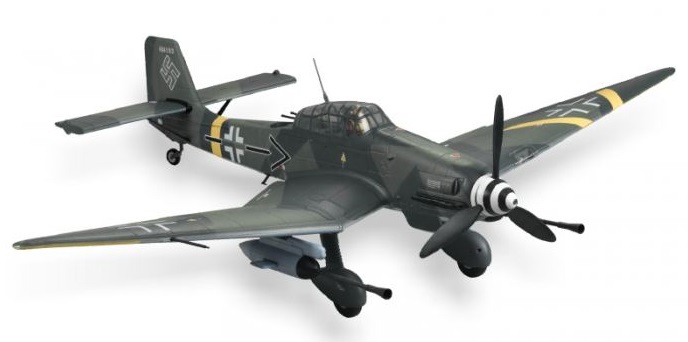
A distinctive feature of such a toy is that the radio-controlled model, unlike most others, can move in three dimensions and can not only ride on the surface, but also fly. The important thing is that regardless of the chosen model, you will be able not only to fly, but to perform the most complex and incredible aerobatics, which can bring real pleasure.
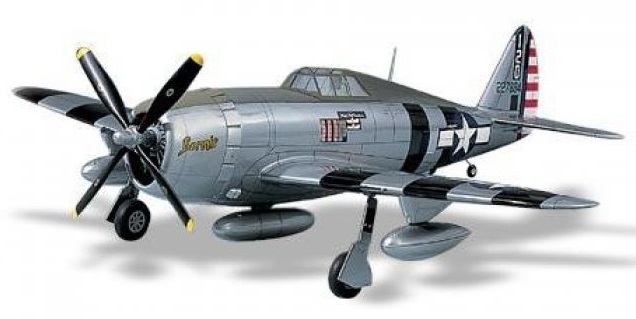 Military radio-controlled aircraft from the online store "Young Dad"
Military radio-controlled aircraft from the online store "Young Dad"
Online store "Young Dad" is ready to offer its customers a wide range of models of military radio-controlled aircraft, so everyone can find what he likes. We have a range of models in every class, from the plywood aircraft that ushered in the era of military aircraft, to the modern military fighter aircraft that virtually all armed forces have come to love. In case of any difficulties, an experienced manager-consultant will come to your aid. He will help you choose the perfect option and then make a purchase for the required aircraft. Each unit of goods meets international quality standards.






